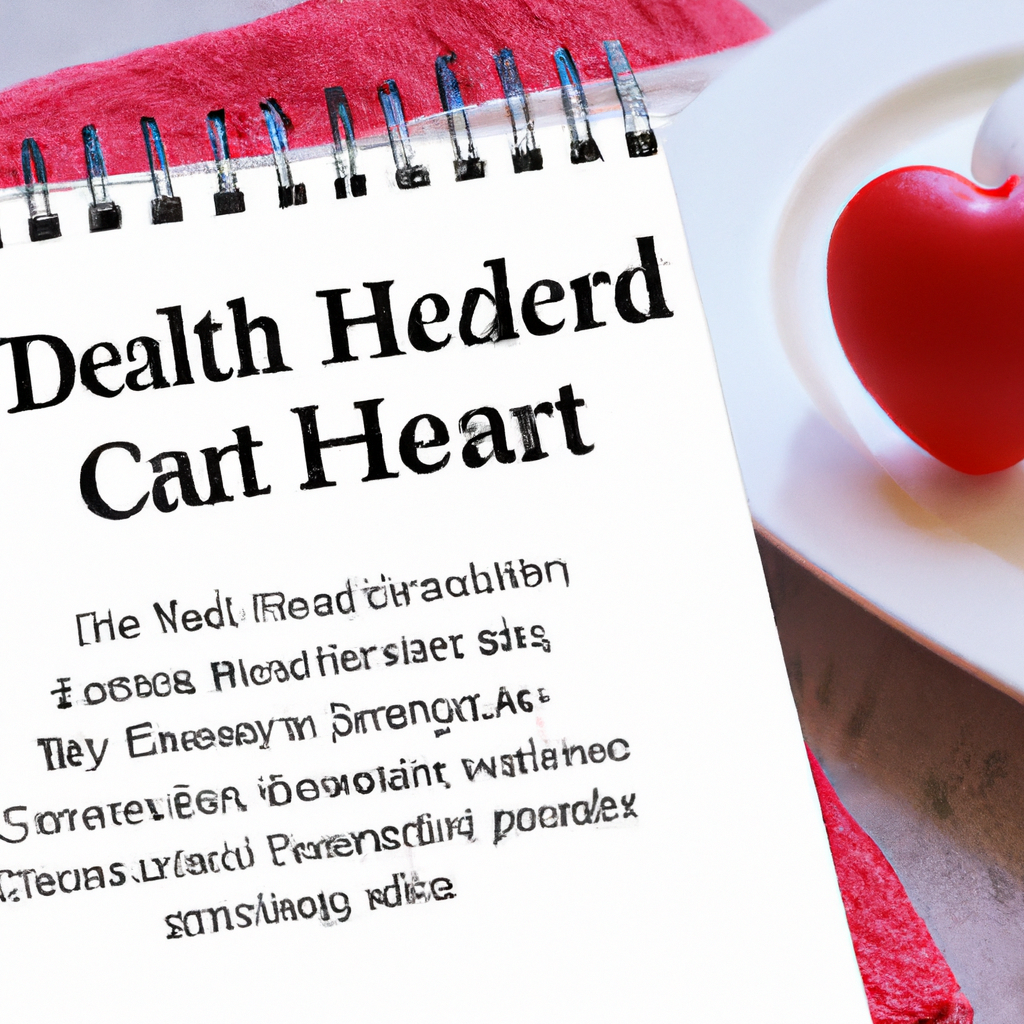A healthy heart is essential for overall wellbeing and living a long, vibrant life. Eating the right foods can help protect your heart, and creating a cardiac diet menu is a great way to ensure you’re getting the right nutrients in the right amounts. By following a meal plan that is specifically tailored to promote heart health, you can enjoy delicious meals that benefit your heart and your overall health.
1. Nourishing the Heart: What is a Cardiac Diet?
The heart is undoubtedly one of the hardiest organs in the human body, pumping and working night and day like a well-oiled machine. However, it is important to keep it nourished with appropriate nutrition to ensure that it continues to remain in its excellent condition for many years to come. A cardiac diet is one of the important ways of taking care of your heart.
A cardiac diet is a set of guidelines about the type of food to eat to ensure overall heart health. It generally emphasizes food sources that are low in saturated fat and cholesterol, while also being high in fiber, antioxidants, and minerals like potassium and magnesium. Some of the considerations for a cardiac diet include:
- Eat lean meats like fish and skinless poultry instead of red and processed meats
- Choose low-fat dairy products
- Replace butter and spread with unsaturated fats
- Opt for fiber-rich foods like oats, brown rice, fresh vegetables and fruits
- Reduce sodium intake to no more than 2,300 milligrams per day
By following a cardiac diet, you can potentially reduce your risk of heart disease, heart attack, stroke, and other health issues. So take care of your heart – and start by following a cardiac diet!
2. Healthy Menu Planning: How to Eat Well for Heart Health
Nutritional choices can have a drastic influence on your heart health. Eating a meal that is lower in saturated fat and cholesterol, while providing essential nutrients like omega-3 fatty acids, may help reduce your risk of developing cardiovascular disease. Here are some tips for healthy menu planning:
- Choose lean protein sources. Lean meats such as skinless chicken and turkey, fish, and vegetarian proteins like beans and tofu are great sources of protein. Avoid fatty meats, processed meats, and red meat.
- Opt for whole grains. Whole-grain breads, cereals, pasta and rice contain more dietary fiber, vitamins, and minerals than processed white grain products.
- Stock up on healthy fats. Look for natural sources of unsaturated fats such as avocados, nuts, and nut butters. Monounsaturated fatty acids found in these foods can help reduce bad cholesterol levels while increasing good cholesterol.
- Include fruits and vegetables. Fruits and veggies are a vital part of a healthy diet. Aim for at least five servings a day to get your daily vitamin and mineral needs.
When planning out your meals and snacks for the week, focus on these helpful tips to keep your heart healthy. Utilizing these tips can help you create a balanced diet that will keep you feeling your best.
3. Delightful and Heart-Friendly Dishes: Ideas and Recipes for Cardiac Meal Plans
Healthy Eating: Eating healthy is essential for managing any condition, and for those with a cardiac condition, it is even more critical. Eating nutritious meals helps reduce and manage the risks associated with cardiac issues.
Creative Dishes: Food doesn’t need to be flavorless or boring to be healthy! Here are a few ideas for incorporating healthy ingredients into delicious and hearty dishes:
- Veggie-stuffed Omelette – mix sautéed onions, mushrooms, and peppers; fill an egg omelette with the filling and top with a sprinkle of cheese.
- Superfood Salad – make a salad with spinach, kale, chickpeas, tomatoes, pears, and walnuts; top with a drizzle of olive oil and lemon.
- Vegan Fettuccine Alfredo – mix tomatoes, zucchini, mushrooms, and garlic; sauté the veggies and add to a creamy Alfredo sauce; serve with healthy whole-grain fettuccine.
- Salmon & Quinoa Bowl – cook quinoa and top with steamed vegetables, roasted salmon, and a drizzle of olive oil.
Utilizing these creative ideas and recipes can help give you a jump-start on finding inspired new ways to make and enjoy heart-healthy dishes. With some creativity and an adventurous palate, you can get creative in the kitchen and make food that meets your dietary needs and delights your taste buds!
4. Optimizing Your Wellness: The Benefits of a Cardiac Diet
Healthy eating doesn’t just benefit your body – it also helps your heart. A cardiac diet is a way of eating that seeks to reduce the strain on your heart with beneficial foods and supplements while eliminating unhealthy, artery-clogging foods. Here’s why you should look into a cardiac diet:
- Lower Blood Pressure: A cardiac diet focuses on balanced foods that are high in fiber, low in sodium, and low in saturated fat – all of which can help to regulate and lower your blood pressure.
- Preventative Care: Eating unhealthy foods raises the risk of developing heart-related diseases. With a cardiac diet, you’re supplying your body with the nutrients it needs to stay healthy and strong, thus ensuring you’re better prepared to fight against any illnesses.
Adopting a cardiac diet can improve your overall wellness not just today but well into the future. By taking the initiative to eat healthier, you’ll give your body the strength and nourishment it needs to stay strong and remain at the top of its game. So give cardiac diet a try – you may start feeling its benefits sooner than you expect!
Eating heart-healthy meals is a great way to support a long, happy life. By following this cardiac diet menu and adding your favorite recipes, you can make sure your diet is nutrient-dense while still being delicious. With this simple, easy-to-follow plan, you can enjoy tasty meals that’ll help your heart beat strong. Bon appetit!
In recent years, the concept of a cardiac diet has become increasingly popular among people looking to enjoy a heart-healthy lifestyle. A cardiac diet, or cardiac diet menu, is meant to reduce the risk of developing cardiovascular diseases by providing meals that are low in cholesterol and saturated fat. By incorporating heart-friendly foods into your diet plan, you can help support your heart health and enjoy a more balanced lifestyle.
Before planning out your meals for the week, it’s important to understand the basics of a heart-healthy diet. The emphasis should be on fruits, vegetables, and other plant-based foods that are high in fiber and contain essential vitamins and minerals. Limit or avoid foods that are high in cholesterol, saturated fat, sodium, and refined sugars, as these can increase the risk of developing chronic heart conditions. Choose lean proteins such as white-meat poultry, seafood, legumes, and beans instead, as these can provide the necessary nutrients without added unhealthy trans fats.
When constructing a cardiac diet, be sure to spread out the meals and snacks throughout the day. Aim for 5-6 small meals, with a few healthy snacks thrown in. Healthy snacks serve as a fuel for the body and offer essential vitamins and minerals that can help support heart health. Examples of nutritious snacks include Greek yogurt, nut butters, and whole grains such as oatmeal. For meals, focus on the foundation of a heart-healthy diet – fruits, vegetables, and lean proteins. Incorporate leafy greens, dark green vegetables such as spinach and broccoli, and unsaturated fats found in salmon.
When selecting foods, it’s important to pay attention to their nutritional values. Check food labels to ensure that you are choosing foods that are low in sugar and saturated fat, as well as free of trans fats. Choosing foods that are high in fiber will help you feel full for longer and reduce cravings for unhealthy snacks. If you are looking for ways to cut down on cholesterol and saturated fat, aim for plant-based proteins such as tofu, lentils, and beans.
Planning out a weekly menu can help make healthy eating easier and more convenient. Choose meals that are satisfying and nutrient-rich to ensure that you are providing your body with the nutrients it needs. By sticking to a cardiac diet menu, you can enjoy meals that are heart-friendly as well as delicious. By following these tips, you can support your heart health and reduce your risk of developing heart-related illnesses.
